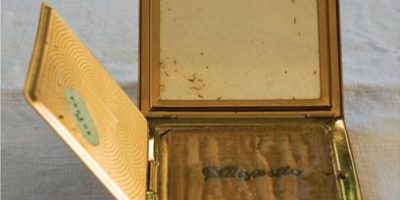Art from the Womb
When Gitl Braun’s art professor suggested, “Go back to your womb,” Braun took the advice literally. The Hasidic mother of eight retreated to her family’s sukkah, which doubles as her studio, and studied a photograph of her uterus, taken after her recent hysterectomy. When she noticed its striking resemblance to the pomegranates strung above her head, something “just clicked,” recalls the Israel-born, London-based artist. “I covered a pomegranate in a cotton serviette, like it was skin, and started to photograph it.” Then she eliminated the fruit and photographed just pieces of gauzy white cloth whose “folds and creases were like a metaphor for the body,” she explains.
This experiment was an important step in a long inward journey, begun only in Braun’s early 50s, when she gained entrance to a five-year program at London’s prestigious Central Saint Martins College of Art and Design. For the first time in her life, the artist — who had entered into an arranged marriage with Marton Braun at age 18 — was asked to explore her womanhood, motherhood and religion. The photographs she created along the way document her self-discovery, and their haunting beauty has struck a chord in the London art world. In the past two years, Braun, modest in both dress and demeanor, has been named one of the top 10 on Saatchi Online, a Web site where thousands of nonprofessional artists display their work. She has shown at several venues in London and at the Soho Synagogue in Manhattan, and is having a solo show in March at London’s The Gallery in Cork Street.
For Braun’s first-ever public exhibition, her graduation show at Saint Martins, she showed her series of fabric images but, sadly, was not there to see them: She was in Israel, sitting shiva for her mother. This intersection of new beginning and ending is a theme running through not only her biography but also her work. Braun — who describes her process in such terms as “giving breath,” “animating” and “bringing to life” — photographs sculptures of her own making. Much of her source material is found by her husband, a lifelong collector of Jewish art and artifacts, such as the Hebrew printing blocks in Braun’s self-described modern masterpiece, Martyred Letters, 2007. She carefully arranged the blocks to look like a pile of rubble and spelled out the words, “Hanehovim Haneimim Vehayesharim,” meaning “The Beloved, The Pleasant, and The Just,” from the Av Harachaman prayer recited on the Sabbath for the souls of the martyrs.
For her most recent series, “Awakening Puppets,” 2007 – 08, she revivified early-19th-century Sicilian wooden dolls by draping them in antique fabrics and assigning them characters, mostly from the Bible. Next, Braun hopes to travel to Catalonia, Spain, to photograph 13th-to-14th-century registrars’ books whose bindings, it was recently discovered, were made from recycled Jewish manuscripts. “Gitl has realized their visual potential, in their raw form,” Marton explains, visibly excited, “as they emerge after burial of 700 or 800 years.”
In other words, Braun, at age 58, will give them something she has also managed to give herself: a second life.


